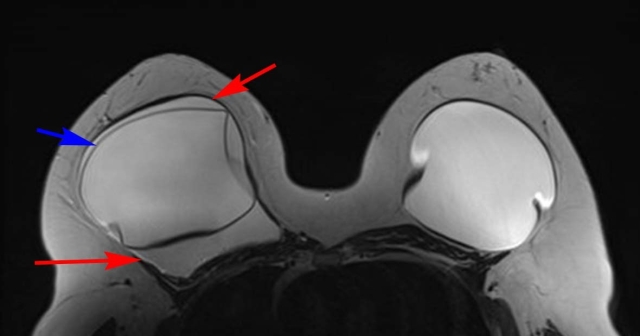There are an increasing number of reports in the media lately about a new relationship between breast implants and an extremely rare form of cancer showing up in the breasts. Notice that I did not say breast cancer. That is because although this cancer is found in the breast, it does not appear to arise from breast tissue.

ALCL surrounding the breast implant in the right breast
This cancer, known as Anaplastic Large Cell Lymphoma and commonly referred to as ALCL, started showing up in cases of women that had persistent fluid accumulation within the fibrous capsule that the body forms when the implant is placed within the breast. Although fluid collections around the implant sometimes occur when the implant is initially placed, this fluid was showing up years after placement and seemed to persist despite typical treatment. As a result, some of these women underwent a second surgery in an attempt to correct the problem. When the fluid was sent for analysis, the cancerous cells were detected.
Reports of this phenomena started showing up in the literature until there were enough eyebrows raised to launch an official investigation by the FDA. Until recently, ALCL was known to be an extremely rare cancer that could involve the breast, but was better known for showing up in other areas of the body. Although it was known to occur in approximately 1 in 500,000 women each year, it only showed up in the breast 3 times for every 100 million women each year. The compilation of all the cases reported however, showed that it had shown up in the breasts of women with implants approximately 60 times worldwide when the total number of implants was estimated between 5 and 10 million.
So what has been concluded from these 60 cases worldwide? Only 34 of these cases had data reported that was deemed reliable enough to be included in the FDA’s study of cases from 1997 though 2010. From a statistical standpoint, there was not enough data to reliably determine any defining characteristics. ALCL occured in both implants with silicone and saline that had been placed for the purpose of reconstruction and augmentation.
Read more: Dr. Ryan Polselli is an expert in the field of breast imaging
There are some reports in the media stating that it is likely that the cancer is being caused by implants that are textured. This is because of the 4 cases of cancer in which the implant shell texture was known, they all happened to be textured. However, this could still be coincidence. We still don’t know what type of shell was involved in the remaining 30 cases.
Because more information is still needed, the FDA has formed a registry in association with the Society of Plastic Surgery to record all cases of ALCL. The FDA is requesting all confirmed cases of ALCL in women with breast implants to be reported to the FDA. The FDA has agreed to keep the reporter and patient’s identity confidential.
So what does all this mean for the average woman with breast implants. In short, don’t be alarmed. The incidence is so low and still so little definite information is known at this point that there is no need to run to your local surgeon to have breast implants removed. In fact, it is the official recommendation of the FDA at this point that implants should not be removed unless there is medical reason. The FDA continues to stand by the overall safety of breast implants when used appropriately.
Ryan Polselli, MD, Diplomate of the American Board of Radiology, Fellowship Trained Breast Imaging Radiologist
Note, this article is for general informational purposes only and is not intended to be medical advice
